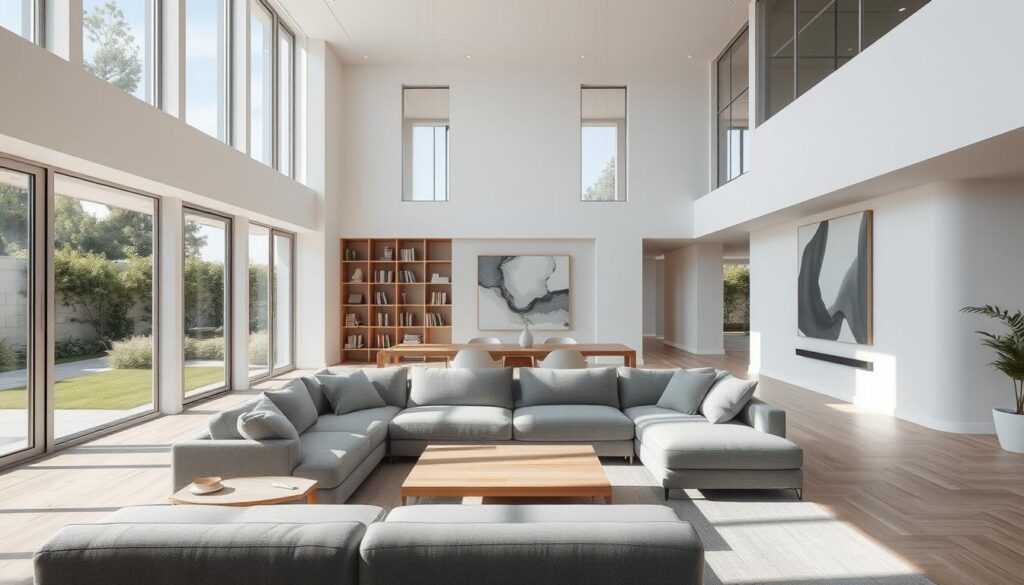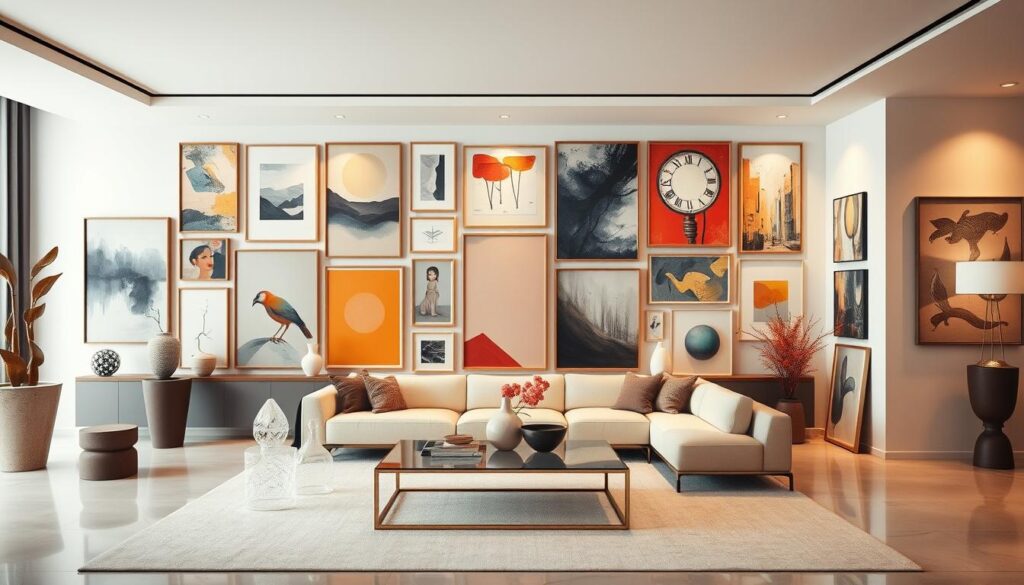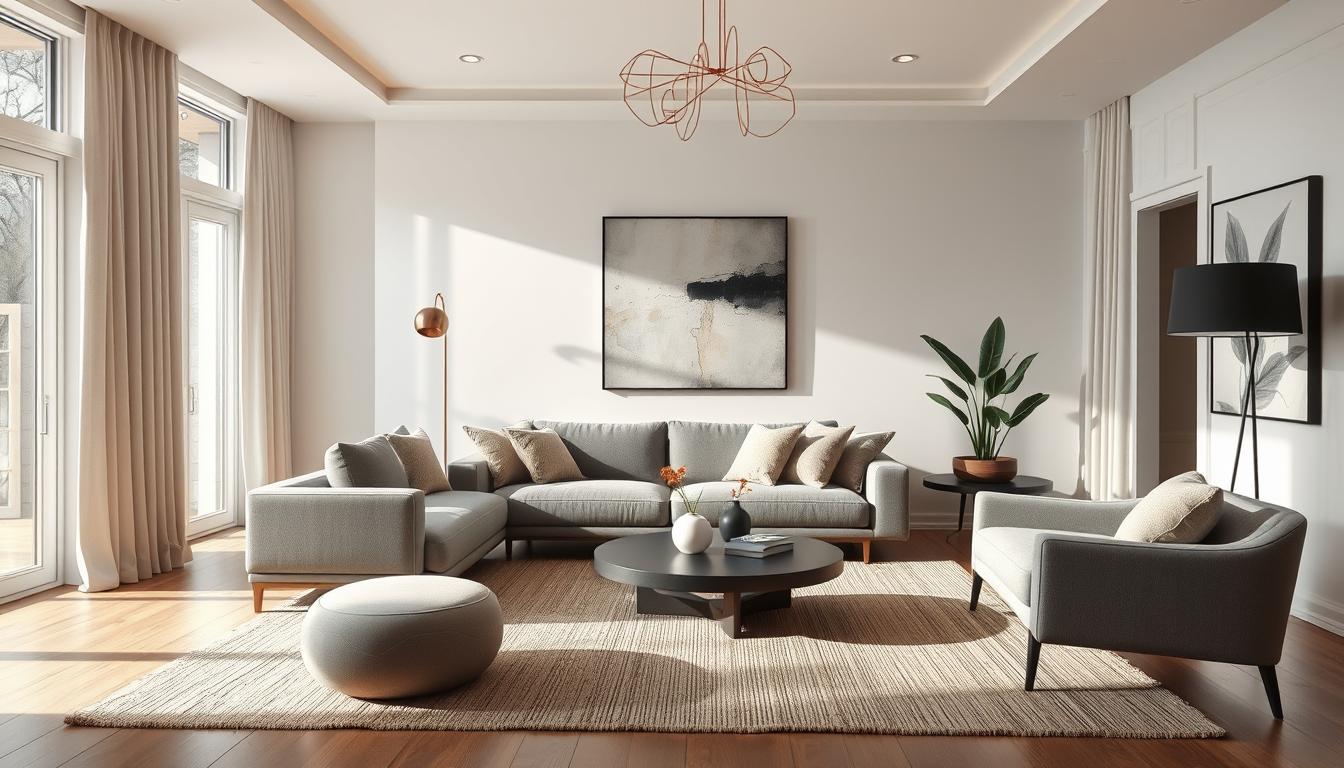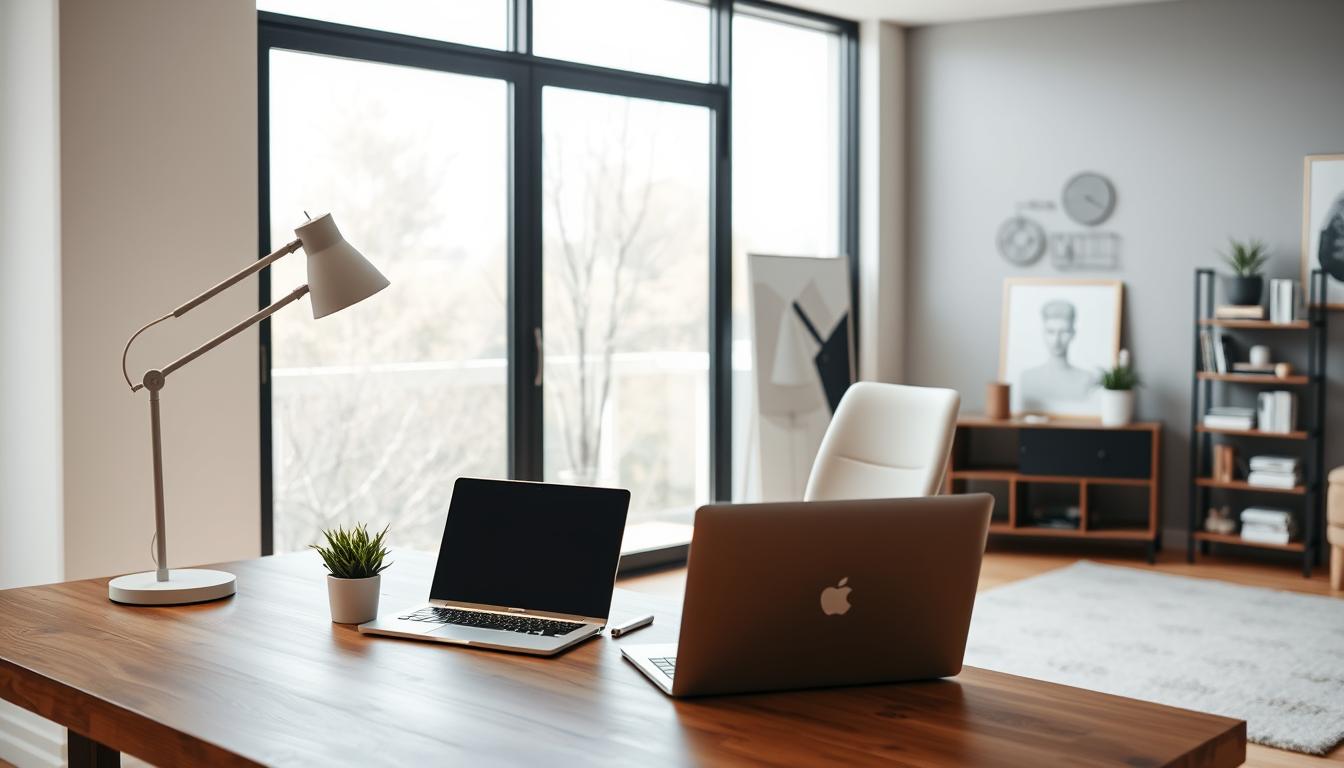In 2025, interior design is moving towards bold colors, green materials, and furniture that does more than one thing. Did you know using eco-friendly materials in your home can make it look better and help the planet? This trend is about making your home both beautiful and good for the environment.
We’ll look at the best ideas for home decor that looks good and works well. With more people caring about the planet, choosing green materials and practices is key. We’ll show you the latest trends and how to add them to your home.
Key Takeaways
- Bold colors are taking center stage in 2025’s interior design trends.
- Sustainable materials are a must for eco-friendly home decor.
- Multifunctional furniture is key to a stylish and functional living space.
- Incorporating eco-friendly practices into your home design is essential.
- Latest trends can be adapted to suit various home decor styles.
Embracing Minimalism in Our Spaces
Minimalist design is a great way to keep our homes tidy. It makes our living spaces calm and simple. This is perfect for today’s busy world.
Key Principles of Minimalist Design
Minimalist design focuses on simplicity and clean lines. It uses a few colors to keep things calm. Here are the main ideas:
- Using natural materials and textures to add depth to a room
- Selecting furniture that is both functional and minimalist in design
- Maintaining a neutral color palette to promote a sense of calm
- Minimizing decor to only the essentials, avoiding clutter
Choosing the Right Color Palette
The color palette is key in minimalist design. We choose neutral colors for the background. This lets us add pops of color with decor or art.
| Color | Effect | Usage |
|---|---|---|
| White | Creates a sense of openness and cleanliness | Walls, trim |
| Gray | Offers balance and neutrality | Furniture, accents |
| Beige | Adds warmth without clutter | Furniture, flooring |
Essential Furniture for Minimalist Interiors
Furniture in minimalist spaces is simple and functional. We choose items with clean lines and no extra details. The must-haves are:
- A sleek sofa that serves as a comfortable seating area
- A minimalist dining table that accommodates gatherings
- A simple, functional desk for home offices
By following these tips, we can make our homes look good and feel peaceful.
Creating Cozy Living Areas
To make a cozy living area, we need to focus on warmth and comfort. It’s not just about looks; it’s about making a space that invites relaxation and togetherness.
Warmth through Lighting
Lighting is key in setting a room’s mood. Warm lighting makes a space feel cozy and welcoming. We can use table lamps, floor lamps, or string lights for this soft glow.
“The right lighting can change a room from cold to warm,” says a famous interior designer. This is very true for living areas where we spend a lot of time.
Selecting Comforting Textures and Fabrics
The textures and fabrics we pick for furniture and decor greatly affect coziness. Plush textiles like velvet, linen, and soft wool add comfort and depth to a room.
- Velvet sofas and armchairs for a luxurious feel
- Linen curtains that filter natural light
- Wool rugs that add warmth underfoot
Incorporating Warmth with Accessories
Accessories are the last touches that make a living area cozy. We can add warmth with throw blankets, decorative pillows, and warm-toned decorative pieces.
By mixing warm lighting, comfy textures and fabrics, and inviting accessories, we can make living areas that are beautiful, cozy, and inviting.
Utilizing Open Floor Plans for Flow
Open floor plans are a key feature of modern homes. They make our living spaces feel open and social. By removing walls, these plans add a sense of space and flow, making our homes look modern and welcoming.
Benefits of Open Spaces
Open floor plans make our homes feel bigger and more open. Without walls, our living areas seem larger and more airy. This setup also encourages socializing, whether we’re cooking, dining, or just hanging out.
Key benefits of open floor plans include:
- Increased sense of space
- Improved social interaction
- Enhanced natural light distribution
- Flexibility in furniture arrangement
Tips for Defining Areas in an Open Layout
Open floor plans can be great, but they can also make it hard to define different areas. We can use design elements to create clear zones.
Area rugs help mark off spaces like living areas or dining spaces. They add color and texture. Furniture placement also helps define areas. For example, a sofa can act as a boundary between the living room and kitchen.
| Method | Description | Benefits |
|---|---|---|
| Area Rugs | Using rugs to define different spaces | Adds texture and color, creates visual boundaries |
| Furniture Placement | Strategically placing furniture to create zones | Creates functional areas, enhances flow |
| Lighting | Utilizing different lighting schemes for various areas | Sets ambiance, highlights specific areas |
In conclusion, open floor plans offer a modern and spacious living solution. They need careful design to define different areas well. By using area rugs, furniture placement, and lighting, we can create stylish and functional spaces that meet our needs.
Incorporating Nature into Our Homes
Adding nature to our homes can greatly improve our well-being. By using biophilic design, we make our homes not just beautiful but also healthy and sustainable.
Biophilic Design Elements
Biophilic design is more than a trend. It’s a way to build and decorate that values nature. Key elements include natural light, ventilation, and natural materials. These elements help us feel closer to nature and make our homes better.
For more ideas on bringing nature into your home, check out 7 gorgeous ways to incorporate nature into your.
Best Indoor Plants for Every Room
Indoor plants are a simple way to add nature to our homes. They clean the air, improve humidity, and add beauty. Some top plants include snake plants, spider plants, and peace lilies.
“Plants are not just decorative elements; they are living beings that can significantly enhance our indoor environments.”
- Snake plants are low maintenance and thrive in low light.
- Spider plants are easy to care for and can be easily shared.
- Peace lilies are beautiful and air-purifying.
Natural Materials in Home Decor
Using natural materials in decor adds warmth and texture. Wood, stone, and bamboo are sustainable and bring the outdoors in.
| Material | Benefits | Uses |
|---|---|---|
| Wood | Sustainable, warm aesthetic | Furniture, flooring |
| Stone | Durable, natural beauty | Countertops, feature walls |
| Bamboo | Fast-growing, versatile | Furniture, flooring, decor |
By using these natural elements, we can make our homes feel connected to nature. This improves our well-being and makes our homes more beautiful.
Choosing the Right Color Schemes
A good color scheme is key to a welcoming home. The colors we pick can really change how we feel and live. They can make our homes feel more inviting and comfortable.
Understanding Color Psychology
Color psychology is very important in home design. Different colors can make us feel different ways. For example, blue tones can make us feel calm and relaxed, great for bedrooms and bathrooms.
Warm colors like orange and red can make us feel more energetic and hungry. They’re perfect for kitchens and dining rooms.
Knowing how colors affect us helps us choose better. We should also think about the light in our rooms. It changes how colors look at different times of day.
Trendy Color Combinations for 2025
In 2025, some color combos are really popular. Mixing deep blues with warm neutrals looks balanced and classy. Another favorite is combining soft greens with earthy tones for a fresh and natural feel.
- Using different shades of one color can make a space look cohesive and calm.
- Pairing colors that are opposite each other on the color wheel adds contrast and interest.
- Colors next to each other on the color wheel create a smooth and soothing look.
By knowing about color psychology and the latest trends, we can pick colors that match our style. They can also make our homes more functional and cozy.
Modern vs. Traditional Design Styles
In the world of interior design, modern and traditional styles are two clear paths. When we design our homes, knowing the differences between these styles is key. It helps us create a space that shows who we are and meets our needs.
Choosing between modern and traditional design is more than just about looks. It’s about the lifestyle and function we want. Let’s dive into the main features of each style to help you decide.
Key Features of Modern Design
Modern design is all about clean lines, less decoration, and focusing on function. It often includes:
- Open floor plans for a spacious feel
- A neutral color scheme with bold touches
- Little decor, with a few standout pieces
- Industrial materials like steel and glass

Modern design is not just about looks. It’s about making our living spaces work well. For example, modern kitchens have sleek appliances and lots of storage. This makes cooking and hosting easier.
Embracing Classic Styles in Our Interiors
Traditional design, by contrast, is all about classic beauty. It often features:
- Warm, rich colors for comfort
- Ornate details like moldings and carvings
- Classic furniture, like armchairs and chandeliers
- Natural materials, like wood and stone
Traditional design makes our homes cozy and welcoming. It’s perfect for those who love comfort and heritage.
| Design Element | Modern Design | Traditional Design |
|---|---|---|
| Color Palette | Neutral with bold accents | Rich, warm tones |
| Furniture | Sleek, minimalist | Classic, ornate |
| Materials | Industrial, like steel and glass | Natural, including wood and stone |
By knowing the basics of modern and traditional design, we can mix them. This way, we can create a unique space that shows our style and meets our needs.
Smart Home Technology in Design
Smart home technology is changing how we design our homes. It makes our homes more useful and easy to use. By adding technology, we improve our homes’ looks and how well they work.
Advantages of Smart Technology
Using smart home tech in design has many benefits. For example, smart lighting systems can be controlled from anywhere. They also adjust based on the time of day, saving energy.
Smart thermostats learn what temperature we like and adjust it. This keeps our homes comfy and cuts down on energy use.
Our homes are also safer with smart tech. Smart door locks and security cameras let us watch our homes and get alerts. Plus, we can use voice assistants to control our homes easily.
Essential Smart Devices
There are key smart devices that make our homes better. Here are some top ones:
| Device | Functionality | Benefits |
|---|---|---|
| Smart Lighting | Remote control and scheduling | Energy efficiency, convenience |
| Smart Thermostats | Temperature adjustment based on preferences | Energy savings, comfort |
| Smart Security Cameras | Real-time monitoring and alerts | Enhanced security, peace of mind |
Looking ahead, smart home tech will keep changing our design choices. By using these technologies, we can make homes that are not just pretty but also useful, green, and safe.
Customizing Our Interior Spaces
Making our living spaces unique is all about adding personal touches. These touches should reflect who we are. This way, our homes become not just beautiful but also deeply personal.
Personal Touches: Artwork and Decor
Artwork and decor are key to adding personality to our homes. Choosing pieces that resonate with us can really make a room stand out. For example, a vibrant art piece can draw the eye and start conversations.
When picking decor, think about your style and the room’s theme. Mixing textures and colors adds depth and interest. This creates a unique and inviting look.

DIY vs. Professional Interior Design
We have two main choices for customizing our spaces: DIY or hiring a professional. The right choice depends on our style, budget, and project size.
DIY design lets us be creative and hands-on. It’s a budget-friendly way to update our homes. With online resources and tutorials, starting is easy.
Working with a professional designer, on the other hand, offers expert advice and access to suppliers. They help turn our vision into reality efficiently.
- DIY interior design offers flexibility and creativity.
- Professional interior designers bring expertise and industry connections.
- Ultimately, the choice depends on our specific needs and preferences.
Knowing the pros and cons of DIY and professional design helps us make the best choice. This way, we can create a living space that truly reflects us.
Sustainable Design Choices for Our Homes
Understanding interior design has grown, showing us how sustainable design choices are key for our homes. This not only helps the environment but also makes our living spaces healthier for us and our families.
Choosing sustainable design can greatly lessen our environmental impact. It also improves our homes’ looks and function. We make smart decisions about materials, energy use, and our design’s overall impact.
Eco-Friendly Materials and Practices
Using eco-friendly materials is a big part of sustainable design. These materials are made and sourced in ways that harm the environment less. Examples are reclaimed wood, bamboo flooring, and paints with low VOCs. Choosing these materials helps lessen our design’s negative effects on the environment.
It’s also important to use sustainable practices in design and building. This includes reducing waste, buying from local suppliers to cut down on emissions, and using energy-efficient solutions.
Reducing Our Environmental Footprint
Reducing our environmental footprint is a main goal of sustainable design. We can do this by using renewable energy, improving insulation to use less energy, and picking materials that can be recycled or are sustainably sourced.
Using recycled materials in our design is another smart move. It cuts down on waste and lowers the need for new, resource-heavy materials. Also, designing spaces that last longer means we don’t have to renovate as often, which is better for the environment.
By choosing sustainable design, we can make homes that are not just beautiful and useful but also good for the planet. As we go forward, it’s vital to keep focusing on sustainability in our design work. This helps make a healthier world for the next generations.
Budget-Friendly Interior Design Ideas
Creating a stylish home doesn’t have to break the bank. We can make our living space beautiful and functional without spending too much. Being creative and resourceful helps us furnish our homes without overspending.
Finding Hidden Gems
Thrifting is a great way to find unique pieces for our homes. We can give old furniture a new life, adding character to our spaces. This not only saves money but also helps reduce waste.
Affordable Decor Solutions
Affordable decor hacks can change every room in our homes. We can rearrange furniture or do DIY decor projects. These budget-friendly ideas help us enjoy a stylish and inviting home.


